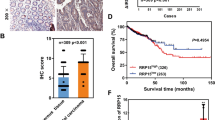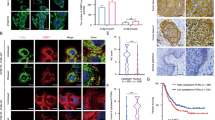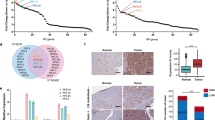Abstract
Lung cancer is the leading cause of cancer deaths and is the most occurring malignancy worldwide. Unraveling the molecular mechanisms involved in lung tumorigenesis will greatly improve therapy. During early tumorigenesis, rapid proliferating tumor cells require increased activity of endoplasmic reticulum (ER) for protein synthesis, folding and secretion, thereby are subjected to ER stress. Ribosome-binding protein 1 (RRBP1) was originally identified as a ribosome-binding protein located on the rough ER and associated with unfolding protein response (UPR). In this report, we investigated the role of RRBP1 in lung cancer. RRBP1 was highly expressed in lung cancer tissue, as compared with adjacent normal tissues as assessed by immunohistochemistry (IHC) using lung cancer tissue array (n=87). Knockdown of RRBP1 by short-hairpin RNAs caused ER stress and significantly reduced cell viability and tumorigenicity. This effect was associated with a significant reduction in the expression of glucose-regulated protein 78 (GRP78). UPR regulator GRP78, an anti-apoptotic protein that is widely upregulated in cancer, has a critical role in chemotherapy resistance in some cancers. According to our results, cells with a higher level of RRBP1 were more resistant to ER stress. Ectopic expression of RRBP1 alleviated apoptosis that was induced by the ER-stress agent tunicamycin, 2-deoxy-D-glucose (2DG) or doxorubicin via enhancing GRP78 protein expression. A strong correlation was observed between the expression of RRBP1 and GRP78 in tumor biopsies using the database GSE10072. Our results also indicated that RRBP1 may involve in the regulation of mRNA stability of UPR components including ATF6 and GRP78. Taken together, RRBP1 could alleviate ER stress and help cancer cell survive. RRBP1 is critical for tumor cell survival, which may make it a useful target in lung cancer treatment and a candidate for the development of new targeted therapeutics.
This is a preview of subscription content, access via your institution
Access options
Subscribe to this journal
Receive 50 print issues and online access
$259.00 per year
only $5.18 per issue
Buy this article
- Purchase on Springer Link
- Instant access to full article PDF
Prices may be subject to local taxes which are calculated during checkout







Similar content being viewed by others
References
Greenlee RT, Hill-Harmon MB, Murray T, Thun M . Cancer statistics. CA Cancer J Clin 2001; 51: 15–36.
Travis WD . Pathology of lung cancer. Clin Chest Med 2002; 23: 65–81.
Strauss GM . Adjuvant chemotherapy of lung cancer. Methodologic issues and therapeutic advances. Hematol Oncol Clin North Am 2005; 19: 263–281.
Shepherd FA . Chemotherapy for advanced non-small-cell lung cancer: modest progress, many choices. J Clin Oncol 2000; 18: 35S–38SS.
Fulda S, Debatin KM . Extrinsic versus intrinsic apoptosis pathways in anticancer chemotherapy. Oncogene 2006; 25: 4798–4811.
Savitz AJ, Meyer DI . Identification of a ribosome receptor in the rough endoplasmic reticulum. Nature 1990; 346: 540–544.
Hyde M, Block-Alper L, Felix J, Webster P, Meyer DI . Induction of secretory pathway components in yeast is associated with increased stability of their mRNA. J Cell Biol 2002; 156: 993–1001.
Krasnov GS, Oparina N, Khankin SL, Mashkova TD, Ershov AN, Zatsepina OG et al. Colorectal cancer 2D-proteomics: identification of altered protein expression. Mol Biol (Mosk) 2009; 43: 348–356.
Bertolotti A, Zhang Y, Hendershot LM, Harding HP, Ron D . Dynamic interaction of BiP and ER stress transducers in the unfolded-protein response. Nat Cell Biol 2000; 2: 326–332.
Shen J, Chen X, Hendershot L, Prywes R . ER stress regulation of ATF6 localization by dissociation of BiP/GRP78 binding and unmasking of Golgi localization signals. Dev Cell 2002; 3: 99–111.
Munro S, Pelham HR . An Hsp70-like protein in the ER: identity with the 78 kd glucose-regulated protein and immunoglobulin heavy chain binding protein. Cell 1986; 46: 291–300.
Lee AS . Mammalian stress response: induction of the glucose-regulated protein family. Curr Opin Cell Biol 1992; 4: 267–273.
Wang Q, He Z, Zhang J, Wang Y, Wang T, Tong S et al. Overexpression of endoplasmic reticulum molecular chaperone GRP94 and GRP78 in human lung cancer tissues and its significance. Cancer Detect Prev 2005; 29: 544–551.
Uramoto H, Sugio K, Oyama T, Nakata S, Ono K, Yoshimastu T et al. Expression of endoplasmic reticulum molecular chaperone Grp78 in human lung cancer and its clinical significance. Lung Cancer 2005; 49: 55–62.
Sasaya H, Utsumi T, Shimoke K, Nakayama H, Matsumura Y, Fukunaga K et al. Nicotine suppresses tunicamycin-induced, but not thapsigargin-induced, expression of GRP78 during ER stress-mediated apoptosis in PC12 cells. J Biochem 2008; 144: 251–257.
Maschek G, Savaraj N, Priebe W, Braunschweiger P, Hamilton K, Tidmarsh GF et al. 2-deoxy-D-glucose increases the efficacy of adriamycin and paclitaxel in human osteosarcoma and non-small cell lung cancers in vivo. Cancer Res 2004; 64: 31–34.
Kurtoglu M, Gao N, Shang J, Maher JC, Lehrman MA, Wangpaichitr M et al. Under normoxia, 2-deoxy-D-glucose elicits cell death in select tumor types not by inhibition of glycolysis but by interfering with N-linked glycosylation. Mol Cancer Ther 2007; 6: 3049–3058.
Yeung BH, Kwan BW, He QY, Lee AS, Liu J, Wong AS . Glucose-regulated protein 78 as a novel effector of BRCA1 for inhibiting stress-induced apoptosis. Oncogene 2008; 27: 6782–6789.
Li J, Lee AS . Stress induction of GRP78/BiP and its role in cancer. Curr Mol Med 2006; 6: 45–54.
Fu Y, Lee AS . Glucose regulated proteins in cancer progression, drug resistance and immunotherapy. Cancer Biol Ther 2006; 5: 741–744.
Langley R, Leung E, Morris C, Berg R, McDonald M, Weaver A . Identification of multiple forms of 180-kDa ribosome receptor in human cells. DNA Cell Biol 1998; 17: 449–460.
Bai JZ, Leung E, Holloway H, Krissansen GW . Alternatively spliced forms of the P180 ribosome receptor differ in their ability to induce the proliferation of rough endoplasmic reticulum. Cell Biol Int 2008; 32: 473–483.
Ogawa-Goto K, Irie S, Omori A, Miura Y, Katano H, Hasegawa H . An endoplasmic reticulum protein, p180, is highly expressed in human cytomegalovirus-permissive cells and interacts with the tegument protein encoded by UL48. J Virol 2002; 76: 2350–2362.
Kim YJ, Lee MC, Kim SJ, Chun JY . Identification and characterization of multiple isoforms of a mouse ribosome receptor. Gene 2000; 261: 337–344.
Jamora C, Dennert G, Lee AS . Inhibition of tumor progression by suppression of stress protein GRP78/BiP induction in fibrosarcoma B/C10ME. Proc Natl Acad Sci USA 1996; 93: 7690–7694.
Bi M, Naczki C, Koritzinsky M, Fels D, Blais J, Hu N et al. ER stress-regulated translation increases tolerance to extreme hypoxia and promotes tumor growth. EMBO J 2005; 24: 3470–3481.
Hoffman RM . The multiple uses of fluorescent proteins to visualize cancer in vivo. Nat Rev Cancer 2005; 5: 796–806.
Hoffman RM, Yang M . Color-coded fluorescence imaging of tumor-host interactions. Nat Protoc 2006; 1: 928–935.
Yang M, Hasegawa S, Jiang P, Wang X, Tan Y, Chishima T . Widespread skeletal metastatic potential of human lung cancer revealed by green fluorescent protein expression. Cancer Res 1998; 58: 4217–4221.
Fidler IJ . Critical factors in the biology of human cancer metastasis: twenty-eighth G.H.A. Clowes memorial award lecture. Cancer Res 1990; 50: 6130–6138.
Urano F, Wang X, Bertolotti A, Zhang Y, Chung P, Harding HP et al. Coupling of stress in the ER to activation of JNK protein kinases by transmembrane protein kinase IRE1. Science 2000; 287: 664–666.
Lee AS . The glucose-regulated proteins: stress induction and clinical applications. Trends Biochem Sci 2001; 26: 504–510.
Lee AS . GRP78 induction in cancer: therapeutic and prognostic implications. Cancer Res 2007; 67: 3496–3499.
Dong D, Ni M, Li J, Xiong S, Ye W, Virrey JJ et al. Critical role of the stress chaperone GRP78/BiP in tumor proliferation, survival, and tumor angiogenesis in transgene-induced mammary tumor development. Cancer Res 2008; 68: 498–505.
Virrey JJ, Dong D, Stiles C, Patterson JB, Pen L, Ni M et al. Stress chaperone GRP78/BiP confers chemoresistance to tumor-associated endothelial cells. Mol Cancer Res 2008; 6: 1268–1275.
Chang J, Chance MR, Nicholas C, Ahmed N, Guilmeau S, Flandez M et al. Proteomic changes during intestinal cell maturation in vivo. J Proteomics 2008; 71: 530–546.
Cox JS, Chapman RE, Walter P . The unfolded protein response coordinates the production of endoplasmic reticulum protein and endoplasmic reticulum membrane. Mol Biol Cell 1997; 8: 1805–1814.
Becker F, Block-Alper L, Nakamura G, Harada J, Wittrup KD, Meyer DI . Expression of the 180-kD ribosome receptor induces membrane proliferation and increased secretory activity in yeast. J Cell Biol 1999; 146: 273–284.
Spear E, Ng DT . The unfolded protein response: no longer just a special teams player. Traffic 2001; 2: 515–523.
Wanker EE, Sun Y, Savitz AJ, Meyer DI . Functional characterization of the 180-kD ribosome receptor in vivo. J Cell Biol 1995; 130: 29–39.
Rose MD, Misra LM, Vogel JP . KAR2, a karyogamy gene, is the yeast homolog of the mammalian BiP/GRP78 gene. Cell 1989; 57: 1211–1221.
Cui XA, Zhang H, Palazzo AF . p180 promotes the ribosome-independent localization of a subset of mRNA to the endoplasmic reticulum. PLoS Biol 2012; 10: 1–18.
Arcamone F, Animati F, Capranico G, Lombardi P, Pratesi G, Manzini S et al. New developments in antitumor anthracyclines. Pharmacol Ther 1997; 76: 117–124.
Kong Q, Lillehei KO . Antioxidant inhibitors for cancer therapy. Med Hypotheses 1998; 51: 405–409.
Reddy RK, Mao C, Baumeister P, Austin RC, Kaufman RJ, Lee AS . Endoplasmic reticulum chaperone protein GRP78 protects cells from apoptosis induced by topoisomerase inhibitors: role of ATP binding site in suppression of caspase-7 activation. J Biol Chem 2003; 278: 20915–20924.
Pyrko P, Schonthal AH, Hofman FM, Chen TC, Lee AS . The unfolded protein response regulator GRP78/BiP as a novel target for increasing chemosensitivity in malignant gliomas. Cancer Res 2007; 67: 9809–9816.
Ranganathan AC, Zhang L, Adam AP, Aguirre-Ghiso JA . Functional coupling of p38-induced up-regulation of BiP and activation of RNA-dependent protein kinase-like endoplasmic reticulum kinase to drug resistance of dormant carcinoma cells. Cancer Res 2006; 66: 1702–1711.
Sobin LH, Fleming ID . TNM Classification of Malignant Tumors, fifth edition. Union Internationale Contre le Cancer and the American Joint Committee on Cancer. Cancer 1997; 80: 1803–1804.
Hoffman RM . Orthotopic metastatic mouse models for anticancer drug discovery and evaluation: a bridge to the clinic. Invest New Drugs 1999; 17: 343–359.
Onn A, Isobe T, Itasaka S, Wu W, O’Reilly MS, Ki Hong W . Development of an orthotopic model to study the biology and therapy of primary human lung cancer in nude mice. Clin Cancer Res 2003; 9: 5532–5539.
Acknowledgements
We thank Miss Tracy Tsai for assisting in the pathological staining analysis. RRBP1 plasmids were kindly provided by Dr Kiyoko, Japan Institute of Leather Research. The study was supported by grants from the National Science Council and Academia Sinica.
Author information
Authors and Affiliations
Corresponding author
Ethics declarations
Competing interests
The authors declare no conflict of interest.
Additional information
Supplementary Information accompanies the paper on the Oncogene website
Supplementary information
Rights and permissions
About this article
Cite this article
Tsai, HY., Yang, YF., Wu, A. et al. Endoplasmic reticulum ribosome-binding protein 1 (RRBP1) overexpression is frequently found in lung cancer patients and alleviates intracellular stress-induced apoptosis through the enhancement of GRP78. Oncogene 32, 4921–4931 (2013). https://doi.org/10.1038/onc.2012.514
Received:
Revised:
Accepted:
Published:
Issue Date:
DOI: https://doi.org/10.1038/onc.2012.514
Keywords
This article is cited by
-
Analysis of the association of ANO3/MUC15, COL4A4, RRBP1, and KLK1 polymorphisms with COPD susceptibility in the Kashi population
BMC Pulmonary Medicine (2022)
-
Endoplasmic reticulum stress increases exosome biogenesis and packaging relevant to sperm maturation in response to oxidative stress in obese mice
Reproductive Biology and Endocrinology (2022)
-
GRP78 in lung cancer
Journal of Translational Medicine (2021)
-
RRBP1 overexpression is associated with progression and prognosis in endometrial endometrioid adenocarcinoma
Diagnostic Pathology (2019)
-
The deubiquitylase OTUD3 stabilizes GRP78 and promotes lung tumorigenesis
Nature Communications (2019)



